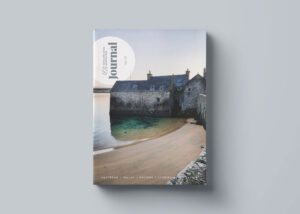by Hayley Anderton

This is not meant as a definitive list, or even a best of list, rather these are ten books that I’ve collected over the years, refer to consistently, and want to celebrate a bit. There are new books in the offing from Mati Ventrillon (Knitting from Fair Isle) this autumn, Gudrun Johnston who is updating some of her mother’s classic Shetland Trader designs, and Mary Jane Mucklestone has a new Fair Isle book in the works too. There will be another Shetland Wool Week annual to collect soon, and the new Shetland Wool Adventures Journal is also on the way so any ‘best of’ is liable to swift change anyway.
It is an annoying truth that far too much of a best of, or definitive list would be out of print – Shetland Textiles 800 BC to the Present edited by Sarah Laurenson being a classic example. It is available on amazon, but for a whopping £3608.99 + £2.80 delivery. As much as I love my copy, I’d be willing to let it go for half of that (and I’d throw in the postage for free too). I’m including it in the hope that at some point the Shetland Museum and Archives might reprint it, and to say that should you see it in a charity shop somewhere, grab it.
Shetland Textiles is a fairly comprehensive overview which starts with what makes the sheep and their wool special, goes through the early history of Shetland, covers spinning, weaving, taatit rugs, the place of textile production in Shetland life, and finishes up with a range of contemporary designers. It’s a beautifully illustrated book, full of inspiration and information. It’s particularly useful for the section on tweed production in the twentieth century. Tweed is still made in Shetland at Jamieson’s mill in Sandness from local wool, but it isn’t easy to find unless you ask for it. Before I read this book I had no idea of the one time scale of the industry.
Carol Christiansen’s Taatit Rugs, the pile bedcovers of Shetland is a groundbreaking work. Taatit rugs seem to be unique to Shetland, they were originally used as bed covers, pattern side down for extra coziness, and were commonly made as wedding presents, one half being provided by each family – hence the mismatched appearance of a lot of them. The more you learn about them the more fascinating they become. The motifs of the earlier rugs are tied to various folk beliefs and thought to have protective qualities. Carol is the textile curator at the Shetland Musuem, this is a scholarly (but not dry) work that really examines the history and evolution of its subject. There’s a lot of interest in here, these rugs are some of the oldest surviving Shetland textiles, and quite apart from anything else I think the book is worth having just to look at the colour combinations. £28.
Susan Crawford’s The Vintage Shetland Project turned out to be an extended eight year labour of love that was more than worth the wait. What it set out to do was create patterns for some of the garments in the museum collection, and we get 27 of them in Fair Isle and lace, for men and women, but in a way that’s the least of what this book does. Susan brings us as much of the history of the original knitters as she can along with all the historical context for the patterns as well. It’s not a cheap book but it’s a worthwhile investment – the patterns are appealing, the essays well researched and interesting, and the photography is lovely – a lot of it was done on the island of Vaila, and is splendidly evocative. The range of the projects is excellent as well. There should be something for everyone here, but it’s a particular treasure trove if you have a passion for vintage style. £48.
Writing this is a welcome reminder that there are an encouraging number of brilliant women researching, writing about, designing, and creating, Shetland, and Shetland inspired knitwear. Kate Davies is another one to add to this list, and at the risk of sounding repetitive I can’t stress enough how good her research is. She has written a handful of books with a Shetland connection and it’s worth having a good look around on her website at them. Colours of Shetland has a couple of designs which have a vintage feel about them, but most are contemporary takes on Kate’s reaction to Shetland, taking inspiration from the colours of the landscape and traditional techniques, but not being overly bound by them. It’s a book of possibilities, and because Kate’s designs in this book are tied to specific places and things some of those possibilities are in how readers might develop our own ideas along the same lines.
I mentioned A Legacy of Shetland Lace previously so I’m leaving it out this time (although it’s brilliant) and instead give you A Shetlander’s Fair Isle Graph Book In Colour also from the Shetland Guild of Spinners, Knitters, Weavers, and Dyers. This is a facsimile edition of 2 graph books dating primarily from the 1930s and 40s. They belonged to Bill Henry who oversaw the knitwear (hosiery) department at Anderson & Co in the mid twentieth century. It’s not clear if he compiled them himself or not. It doesn’t matter. The joy of this book is the colour aspect. It’s joyful riot of colour. Most collections of Fair Isle motifs are done in black and white; I have seen some personal collections which use various coloured dots – but nothing quite like this which would allow you to plan entire garments in original colourways. There’s also something particularly wonderful about seeing something in colour from an era where surviving photographs are monotone.
All the Guild books are available from The Shetland Times bookshop.
Traditional Fair Isle Knitting by Sheila McGregor is the first knitting book I bought (from the Shetland Times Bookshop on a wet and windy March day after filling a carrier bag with a rainbow of colours from Jamieson’s just down the street, it is a happy memory). I was determined I was going to relearn how to knit, and I wanted to start with Fair Isle. There are several books that catalogue motifs, Mary Smith’s A Shetland Pattern Book is the one I’d most like to see come back into print. It’s available if you search for it, but at around £30 second hand is probably not worth the money. My sister has a copy, but perhaps wisely she refuses to lend it to me. The advantages of the Sheila McGregor book are that it covers background and origins along with chapters on design, techniques, and colour, and has a good index. I’ve used it almost exclusively for choosing patterns from and refer to it a lot. Highly recommended! It’s widely available.
Marie Wallin’s Shetland is a collection of twelve Fair Isle patterns. A lot of Marie’s work uses Fair Isle so again it’s worth having a good look around her website. Her use of colour is particularly pleasing, and this is a nice book to look at. The range of garments is excellent as well. There are smaller projects in here which are good for the relative novice (the Skerries mitts are a perfect place to begin) and a useful range of shapes amongst the jumpers and cardigans so there should also be something for most body types as well. The other really nice touch is that a couple of Aisling Doonan’s lace patterns are showcased (patterns not included). Aisling’s work is amazing, finding her was an unexpected bonus from this particular book.
Chihiro Sato’s Enjoy Fair Isle Knitting comes with a lot of useful instructions and diagrams for construction. Chihiro fell in love with Shetland when she first visited in 1989, and she’s been returning ever since as well as importing Shetland yarn to Japan. Her designs stand out for the way that they respect traditional Shetland techniques whilst bringing in elements that are distinctly Japanese. The way she uses colour is interesting as well; putting colours together is, I find, the hardest thing about Fair Isle knitting, so I can never have too much inspiration for this, or enough examples. Published by the Shetland Times at £28.99
Elizabeth Lovick’s The Magic of Shetland Lace Knitting might well have been the second knitting book I bought, after the McGregor book it’s the one I turn to most often. It’s a really good place to start learning about Shetland lace from. There are clear instructions about techniques and designing, as well as a range of projects to try making – although if I’m honest none of them particularly appealed to me. The great thing about this book is the stitch directory. Instructions are mostly written as well as charted, so whichever method you prefer you should have no problem following patterns. They’re all also clearly graded into levels of difficulty which is beyond helpful for total beginners. The easy patterns really are easy and there’s a clear pathway to follow if you want to build skills and experience on the way to tackling something big.
The big project might well come from Sharon Miller’s Heirloom Knitting. This book was generally accepted as a ground breaking game changer when it first came out in 2002. It hasn’t been bettered since. It’s still on The Shetland Times website, although showing as sold out. I hope that means that it’s being reprinted. There’s so much in this book that it’s hard to know where to start other than to say that any serious lace knitter needs it in their library. As a far from expert lace knitter I’ve spent a lot of time looking at some of these patterns in complete awe. It is the bible for Shetland lace knitting, and a treasure in itself every bit as much as anything you might make from it.
The brand new Shetland Wool Adventures Journal is a celebration of knitting, craft, creativity, adventure and all things Shetland and the publication will be ready at the end of August. You can follow the progress of the Journal here as well as pre-ordering a copy here. It looks set to be excellent.



When will the journal be ready for delivery as l am moving house and don’t want to miss it. I haven’t pre ordered yet
Hello Sheila, it will be ready for shipping at the end of August. Thank you for your interest!
Loved the list, now I have some new books to look for!
A few of my favorites to add;
Knitted Tams by Mary Rowe
Knitting Fair Isle Mittens and Gloves by Carol Rasmussen Noble
In the Footsteps of Sheep by Debbie Zawinski
Many thanks for this very good idea ! This list is very interesting. Being French, I will not have many opportunities to grab one of these but I keep them on my “ to read” list, and who knows…One of them might fall into my hands somewhere…!
Thank you for the list. My mam worked in the tweed making industry in the 1950’s/60’s and then with fair isle knitwear. I will never forget the speed of her fingers whilst knitting. I would love to try to find a copy of ‘Shetland Textiles 800BC to Present’. I certainly hope it will be reprinted in the future.
Lovely list.. as it turns out I have some of these so I enthusiastically second your recommendations. Also I am so happy to see Matti Ventrillon’s new book on the list, but I must confess my bias…I was one of Matti’s test knitters! Looking forward to receiving already ordered copy of your book also. Best of luck on your newest (ad)venture!
How can I preorder The Shetland wool adventures journal?